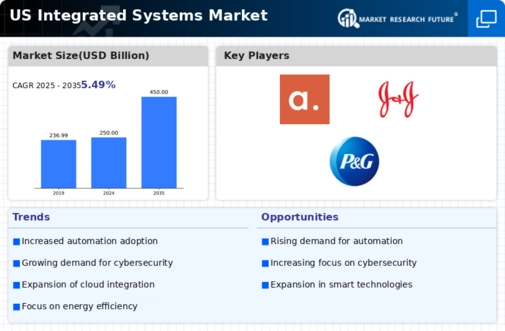Advancements in IoT Technology
The proliferation of Internet of Things (IoT) devices is significantly influencing the integrated systems market. As more devices become interconnected, the need for integrated systems that can manage and analyze data from these devices is paramount. This trend is particularly relevant in sectors such as smart cities and industrial automation, where real-time data processing is essential. This market is expected to witness a growth rate of approximately 15% annually., driven by the increasing adoption of IoT technologies. Companies are investing in integrated systems that can harness IoT data to optimize operations, improve decision-making, and enhance customer experiences, thereby propelling market growth.
Growing Cybersecurity Concerns
As cybersecurity threats continue to evolve, This market is witnessing a surge in demand for solutions that prioritize security.. Organizations are increasingly aware of the vulnerabilities associated with disparate systems and are seeking integrated solutions that offer robust security features. This trend is particularly relevant in sectors such as finance and healthcare, where data breaches can have severe consequences. The integrated systems market is expected to grow at a rate of 11% annually, driven by the need for enhanced cybersecurity measures. Companies are investing in integrated systems that not only streamline operations but also provide comprehensive security protocols, thereby addressing the growing concerns surrounding data protection.
Rising Demand for Customization
The integrated systems market is experiencing a notable rise in demand for customized solutions tailored to specific business needs. Companies are increasingly seeking integrated systems that can seamlessly align with their operational workflows, enhancing efficiency and productivity. This trend is particularly evident in sectors such as manufacturing and healthcare, where unique requirements necessitate bespoke solutions. According to recent data, the customization segment is projected to grow at a CAGR of 12% over the next five years, indicating a robust shift towards personalized integrated systems. As organizations strive to differentiate themselves in competitive landscapes, the ability to offer tailored integrated systems becomes a critical driver in the market.
Regulatory Compliance Requirements
The integrated systems market is increasingly shaped by the need for compliance with various regulatory standards. Industries such as finance, healthcare, and telecommunications are subject to stringent regulations that necessitate the integration of systems to ensure data integrity and security. As organizations strive to meet these compliance requirements, the demand for integrated systems that can provide comprehensive reporting and auditing capabilities is on the rise. The market is projected to expand by approximately 10% annually as businesses invest in solutions that not only meet regulatory standards but also enhance operational transparency. This driver underscores the critical role of integrated systems in facilitating compliance across diverse sectors.
Increased Focus on Operational Efficiency
Organizations across various sectors are placing a heightened emphasis on operational efficiency, which serves as a significant driver for the integrated systems market. By integrating disparate systems, businesses can streamline processes, reduce redundancies, and enhance overall productivity. This focus on efficiency is particularly pronounced in industries such as logistics and retail, where timely information flow is crucial. Recent studies indicate that companies implementing integrated systems can achieve up to a 30% reduction in operational costs. As businesses continue to seek ways to optimize their operations, the demand for integrated systems that facilitate these improvements is likely to grow, further energizing the market.













Leave a Comment